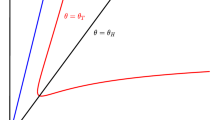Abstract
A system of retarded functional differential equations is proposed as a predator-prey model with stage structure in the prey. The invariance of non-negativity, nature of boundary equilibria and global stability are analyzed. It is shown that in this model the time delay can make a stable equilibrium become unstable and even a switching of stabilities.
Similar content being viewed by others
References
Chen Lansun, Mathematical Models and Methods in Ecology, Beijing: Science Press, 1988, (in Chinese).
Hofbauer, J., Sigmund, K., Evolutionary Games and Population Dynamics, Cambridge: Cambridge University Press, 1998.
Freedman, H.I., Deterministic Mathematical Models in Population Ecology, New York: Marcel Dekker, 1980.
Kuang Yang, Delay Differential Equations with Applications in Population Dynamics, New York: Academic Press, 1993.
Wang Wendi, Chen Lansun, A predator-prey system with stage structure for predator, Comput. Math. App., 1997,33(8):83–91.
Cui Jiang’an, Chen Lansun, Wang Wendi, The effect of dispersal on population growth with stage-structure, Comput. Math. App., 2000,39:91–102.
Kjartan, M., Destabilizing effect of cannibalism on a structured predator-prey system, Math. Biosci., 1999,155:61–75.
Aiello, W. G., Freedman, H. I., A time-delay model of single-species growth with stage structure, Math. Biosci., 1990,101:139–153.
Song Xinyu, Chen Lansun, Optimal harvesting and stability for a two species competitive system with stage structure, Math. Biosic., 2001,170:173–186.
Song Xinyu, Chen, Lansun, Optimal harvesting and stability for a predator-prey system with stage structure, Acta Math. App. Sinica, 2002,18:423–430.
Diekmann, O., Nisbet, R. M., Gurney, W. S. C.,et al, Simple mathematical models for cannibalism: a critique and a new approach, Math. Biosci., 1986,78:21–46.
Hastings, A., Cycles in cannibalistic egg-larval interactions, J. Math. Biol., 1987,24:651–666.
Yang Xia, Chen Lansun, Chen Jufang, Permanence and positive periodic solution for the single-species nonautonomous delay diffusive model, Comput. Math. Appl., 1996,32:109–116.
Freedman, H.I., Sree Hari Rao, V., The trade-off between mutual interference and time lags in predato-prey systems, Bull. Math. Biol., 1983,45:991–1003.
Hale, J.K., Theory of Functional Differential Equations, New York: Springer-Verlag, 1977.
Hale, J. K., Ordinary Differential Equations, New York: Wiley, 1969.
Author information
Authors and Affiliations
Additional information
Supported by the National Natural Science Foundation of China (10171106) and Natural Science Foundation of Henan Province (0211010400).
Rights and permissions
About this article
Cite this article
Ye, K., Song, X. Predator-prey system with stage structure and delay. Appl. Math. Chin. Univ. 18, 143–150 (2003). https://doi.org/10.1007/s11766-003-0018-1
Received:
Issue Date:
DOI: https://doi.org/10.1007/s11766-003-0018-1




